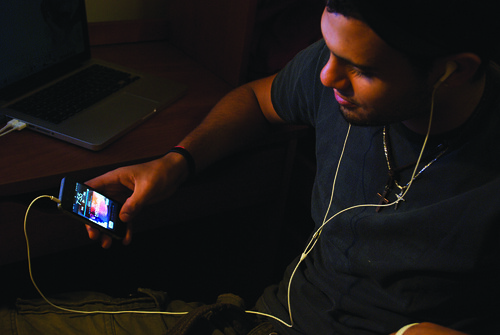A new study predicts as many as 20 percent of students are affected.
Main Campus is being painted white with those little white earbuds, which are spreading in a large number of college campuses across the country, saysaccording to a study published in January by the Kaiser Family Foundation.
Results of the study indicate that the number of young adults, ages 8 to 18, who own an MP3 player jumped from 18 percent in 2004 to 76 percent in 2009, an increase of 322 percent. The study shows that not only are young people buying them in higher volumes, but they are spending more and more time listening to them.
Time spent listening to music has increased from 47 minutes a day in 2004 to just more than 2.5 hours a day in 2009. Of that time, almost an hour of it ends up coming out of those little white headphones.

Outside of infuriating the music industry due to a high rate of illegal downloading, this increased listening trend has physicians calling for a change.
According to a recently published study by the Journal of the American Medical Association, young people are showing an increased rate of hearing loss. The study, which focused on young adults, found an increase in either slight loss (between 15 dB and 25 dB) or mild or greater loss (greater than 25 dB).
For comparison purposes, a quiet whisper in the library is around 30 dB, a telephone dial tone is around 80 dB and a motorcycle is around 100 dB.
The study, which focused on young people aged 12-to-19-year-olds between 2005 and 2006, cites MP3 players as a possible cause of the increase in hearing loss.
“It’s not about the file type that is being used but about the time spent with the ear buds,” said Jack Klotz, a communicationsan associate professor of broadcasting and mass media, said.
The Occupational Safety and Health Administration’s current regulations state that employers are only allowed to expose their workers to sounds of 100 dB for no more than two hours per day.
But according to Klotz, those are the same sound levels young people are exposing themselves to with their music devices.
He says the recording studios have started lowering the difference between the top quarter of frequencies – known as transience – and the lower quarter of frequencies.
Then, using a compressor, they move all the frequencies upward. The end result is that the song has a higher apparent volume, but the drums in the background seem less crisp.
It’s a trend that “infuriates producers and audio engineers,” Klotz said. However, since most listeners want to feel the full force of that “Smells Like Teen Spirit” drum beat, the volume gets turned up even higher.
MP3 player-listening and frequent concert-going are factors of city life that both Klotz and Dr. John Krouse, the head of the otolaryngology department, agree could be leading to this rate of hearing loss.
“If the sound is loud enough to hurt, or if the sound is loud enough to cause ringing in the ears, then it is causing some damage,” Krouse said.
Some tips to prevent permanent hearing loss: Get better headphones than the Apple-distributed white earbuds, and turn down the volume.
Nadia Elkaddi can be reached at nadia.elkaddi@temple.edu.



Be the first to comment